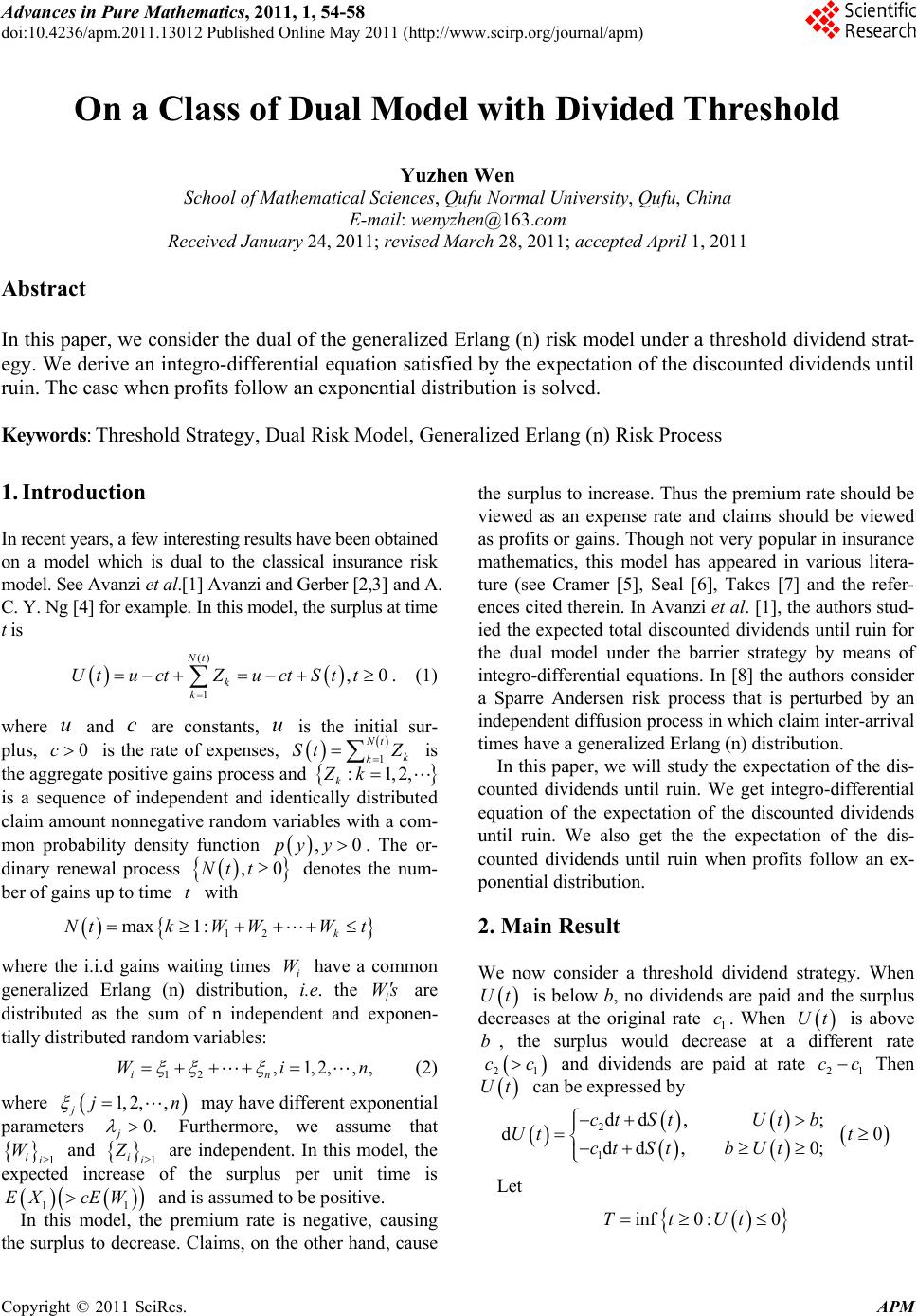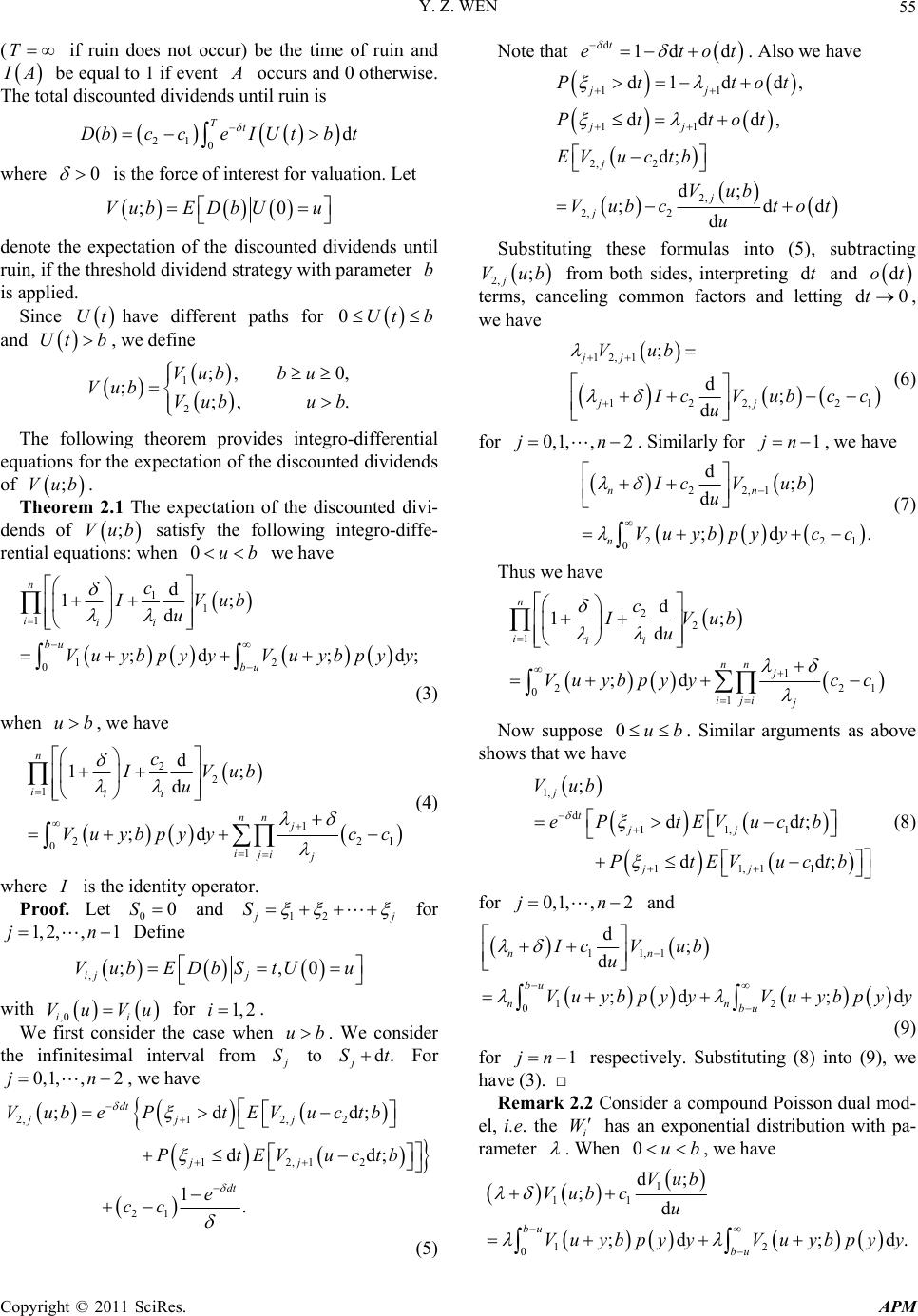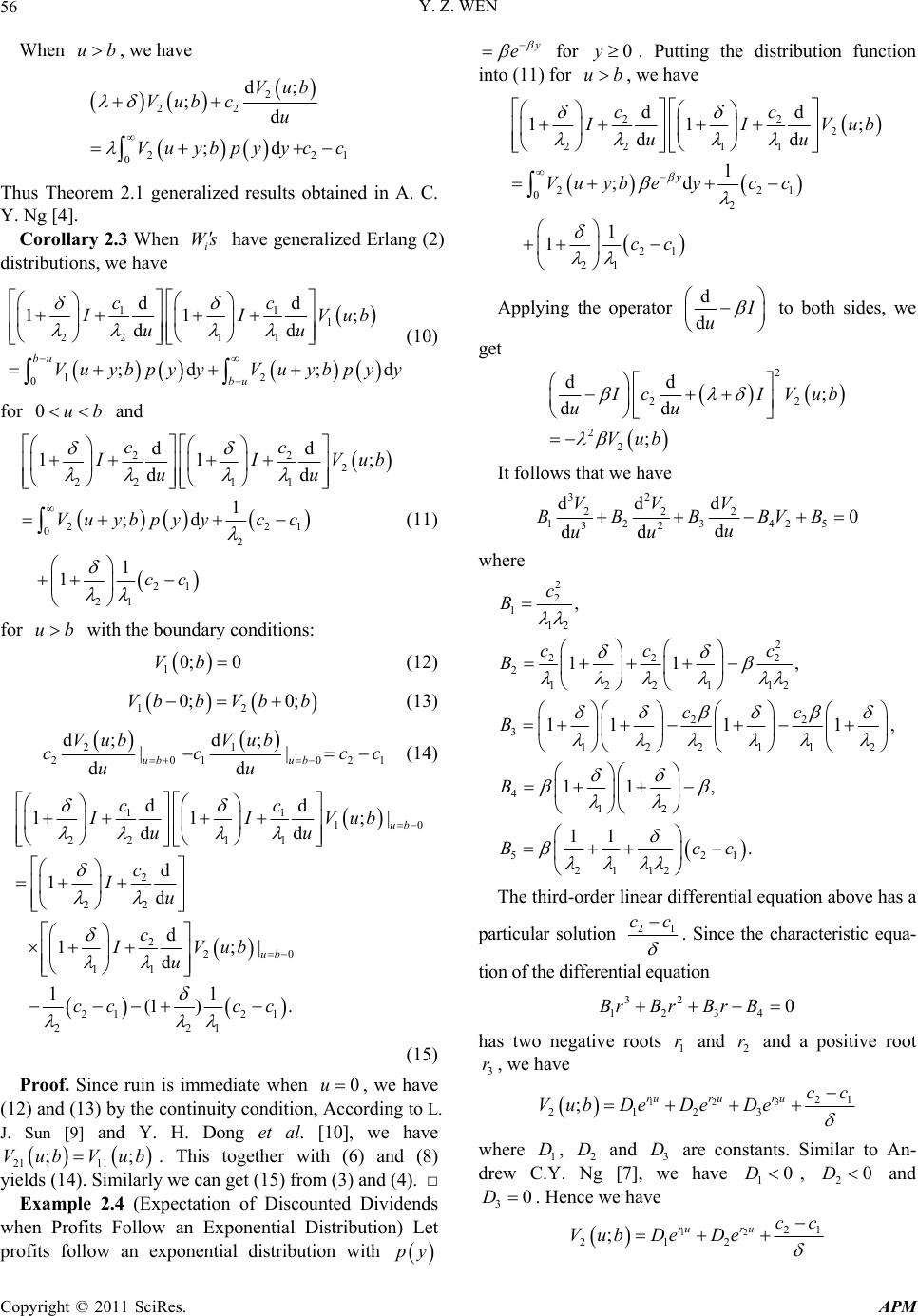 Advances in Pure Mathematics, 2011, 1, 54-58 doi:10.4236/apm.2011.13012 Published Online May 2011 (http://www.scirp.org/journal/apm) Copyright © 2011 SciRes. APM On a Class of Dual Model with Divided Threshold Yuzhen Wen School of Mathemat i cal Sci ences, Qufu Normal University, Qufu, China E-mail: wenyzhen@163.com Received January 24, 2011; revised March 28, 2011; acce pted April 1, 2011 Abstract In this paper, we consider the dual of the generalized Erlang (n) risk model under a threshold dividend strat- egy. We derive an integro-differential equation satisfied by the expectation of the discounted dividends until ruin. The case when profits follow an exponential distribution is solved. Keywords: Threshold Strategy, Dual Risk Model, Generalized Erlang (n) Risk Process 1. Introduction In recent years, a few interesting results have been obtained on a model which is dual to the classical insurance risk model. See Avanzi et al.[1] Avanzi and Gerber [2,3] and A. C. Y. Ng [4] for example. In this model, the surplus at time t is () 1 ,0 Nt k k UtuctZuctSt t . (1) where u and c are constants, u is the initial sur- plus, 0c is the rate of expenses, 1 Nt k k St Z is the aggregate positive gains process and :1,2, k Zk is a sequence of independent and identically distributed claim amount nonnegative random variables with a com- mon probability density function ,0py y. The or- dinary renewal process ,0Nt t denotes the num- ber of gains up to time t with 12 max 1:k NtkW WWt where the i.i.d gains waiting times i W have a common generalized Erlang (n) distribution, i.e. the i Ws are distributed as the sum of n independent and exponen- tially distributed random variables: 12 ,1,2,,, in Win (2) where 1, 2,, jjn may have different exponential parameters 0. j Furthermore, we assume that 1 ii W and 1 ii Z are independent. In this model, the expected increase of the surplus per unit time is 11 EX cEW and is assumed to be positive. In this model, the premium rate is negative, causing the surplus to decrease. Claims, on the other hand, cause the surplus to increase. Thus the premium rate should be viewed as an expense rate and claims should be viewed as profits or gains. Though not very popular in insurance mathematics, this model has appeared in various litera- ture (see Cramer [5], Seal [6], Takcs [7] and the refer- ences cited therein. In Avanzi et al. [1], the authors stud- ied the expected total discounted dividends until ruin for the dual model under the barrier strategy by means of integro-differential equations. In [8] the authors consider a Sparre Andersen risk process that is perturbed by an independent diffusion process in which claim inter-arrival times have a generalized Erlang (n) distribution. In this paper, we will study the expectation of the dis- counted dividends until ruin. We get integro-differential equation of the expectation of the discounted dividends until ruin. We also get the the expectation of the dis- counted dividends until ruin when profits follow an ex- ponential distribution. 2. Main Result We now consider a threshold dividend strategy. When Ut is below b, no dividends are paid and the surplus decreases at the original rate 1 c. When Ut is above b, the surplus would decrease at a different rate 21 cc and dividends are paid at rate 21 cc Then Ut can be expressed by 2 1 dd ,; ddd ,0; ct StUt b Ut ctStb Ut 0t Let inf0 :0TtUt  Y. Z. WEN Copyright © 2011 SciRes. APM 55 (T if ruin does not occur) be the time of ruin and A be equal to 1 if event occurs and 0 otherwise. The total discounted dividends until ruin is 21 0 () d Tt DbcceIUtbt where 0 is the force of interest for valuation. Let ;0Vub EDbUu denote the expectation of the discounted dividends until ruin, if the threshold dividend strategy with parameter b is applied. Since Ut have different paths for 0Ut b and Ut b, we define 1 2 ;, 0, ;;, . Vubb u Vub Vubub The following theorem provides integro-differential equations for the expectation of the discounted dividends of ;Vub. Theorem 2.1 The expectation of the discounted divi- dends of ;Vub satisfy the following integro-diffe- rential equations: when 0ub we have 1 1 1 12 0 d 1; d ;d ;d; n iii bu bu c IVub u Vu ybpy yVu ybpy y (3) when ub, we have 2 2 1 1 221 01 d 1; d ;d n iii n nj iji j c IVub u Vu ybpyycc (4) where is the identity operator. Proof. Let 00S and 12 j S for 1, 2,,1jn Define ,;,0 ij j Vub EDbS tUu with ,0ii VuVu for 1, 2 i. We first consider the case when ub. We consider the infinitesimal interval from S to d. j St For 0,1, ,2jn, we have 2,12, 2 12,12 21 ;dd; dd; 1. dt jjj jj dt Vube PtEVuctb PtEVuctb e cc (5) Note that d1d d t etot . Also we have 11 11 2, 2 2, 2, 2 d1dd, ddd, d; d; ;dd d jj jj j j j Pt tot Pttot EVuc tb Vub Vubc tot u Substituting these formulas into (5), subtracting 2, ; j Vub from both sides, interpreting dt and dot terms, canceling common factors and letting d0t, we have 12, 1 122,21 ; d; d jj jj Vub cVubcc u (6) for 0,1,,2jn . Similarly for 1jn , we have 22,1 221 0 d; d ;d . nn n IcV ub u Vu ybpyycc (7) Thus we have 2 2 1 1 221 01 d 1; d ;d n iii n nj iji j c IVub u Vu ybpyycc Now suppose 0ub . Similar arguments as above shows that we have 1, d 11,1 11,11 ; dd; dd; j tjj jj Vub eP tEVuctb PtEVuctb (8) for 0,1,,2jn and 11,1 12 0 d; d ;d ;d nn bu nn bu IcVub u Vu ybpy yVu ybpy y (9) for 1jn respectively. Substituting (8) into (9), we have (3). □ Remark 2.2 Consider a compound Poisson dual mod- el, i.e. the i W has an exponential distribution with pa- rameter . When 0ub , we have 1 11 12 0 d; ;d ;d ;d. bu bu Vub Vub cu Vu ybpy yVu ybpy y  Y. Z. WEN Copyright © 2011 SciRes. APM 56 When ub, we have 2 22 221 0 d; ;d ;d Vub Vub cu Vuybpyyc c Thus Theorem 2.1 generalized results obtained in A. C. Y. Ng [4]. Corolla ry 2.3 When i Ws have generalized Erlang (2) distributions, we have 11 1 22 11 12 0 dd 11 ; dd ;d ;d bu bu cc IIVub uu Vu ybpy yVu ybpy y (10) for 0ub and 22 2 22 11 221 0 2 21 21 dd 11 ; dd 1 ;d 1 1 cc IVub uu Vuybpyyc c cc (11) for ub with the boundary conditions: 10; 0Vb (12) 12 0; 0;Vbb Vbb (13) 21 201021 d; d; || dd ub ub Vub Vub cccc uu (14) 11 10 22 11 2 22 2 20 11 21 21 221 dd 11 ;| dd d 1d d 1;| d 11 (1 ). ub ub cc IIVub uu c Iu c IVub u cc cc (15) Proof. Since ruin is immediate when 0u, we have (12) and (13) by the continuity condition, According to L. J. Sun [9] and Y. H. Dong et al. [10], we have 21 11 ;;Vub Vub. This together with (6) and (8) yields (14). Similarly we can get (15) from (3) and (4). □ Example 2.4 (Expectation of Discounted Dividends when Profits Follow an Exponential Distribution) Let profits follow an exponential distribution with py e for 0y. Putting the distribution function into (11) for ub, we have 22 2 22 11 221 0 2 21 21 dd 11 ; dd 1 ;d 1 1 y cc IVub uu Vuybeycc cc Applying the operator d d u to both sides, we get 2 22 2 2 dd ; dd ; cIVub uu Vub It follows that we have 32 222 123425 32 ddd 0 d dd VVV BBBBVB u uu where 2 2 1 12 2 22 2 2 1221 12 22 3 122112 4 12 521 2112 , 11 , 111 1, 11 , 11 . c B cc c B cc B B Bcc The third-order linear differential equation above has a particular solution 21 cc . Since the characteristic equa- tion of the differential equation 32 1234 0BrBrBr B has two negative roots 1 r and 2 r and a positive root 3 r, we have 3 12 21 2123 ;ru ru rucc Vub DeDeDe where 1 D, 2 D and 3 D are constants. Similar to An- drew C.Y. Ng [7], we have 10D, 20D and 30D . Hence we have 12 21 212 ;ruru cc Vub DeDe  Y. Z. WEN Copyright © 2011 SciRes. APM 57 We put the distribution function of py e into (10). Then, for 0bu, we have 11 1 22 11 1 0 2 dd 11 ; dd ;d ;d. bu y y bu cc IVub uu Vu ybey Vu ybey (16) Applying the operator d d u to both sides, we get 32 111 12341 32 ddd 0 d dd VVV BBBBV u uu where 2 1 1 12 2 11 1 2 1221 12 11 3 122112 4 12 , 11 , 1111, 11. c B cc c B cc B B Hence we have 3 12 1123 ; u su su Vub EeEeEe where 1 E, 2 E and 3 E are constants, 1 , 2 and 3 12 3 0sss are the solutions of the character- istic equation 32 1234 0BsBsBs B Since 0, 0Vb, we get 123 0.EEE (17) Substituting back the solution for 1;Vub and 2;Vub into (16), we have 3 12 1 2 11 22 11 12 3 1 1 1 221 2 dd 11 dd ;d . su su su burb uy u urb bu cc II uu Ee EeEe D eVybey e r Dcc ee r Since the expression above must be satisfied for all 0ub, the sum of the coefficients of u e must be zero. Thus we have 3 12 12 3 12 123 1221 12 0 sb sb sb rb rb Ee Ee Ee sss DeDec c rr (18) On the other hand, since 12 0; 0;Vbb Vbb , we have 3 12 12 12 3 21 12 su su su rb rb Ee EeEe cc De De (19) It follows from (10) and (11) that we have 3 12 12 11 22 11 12 3 22 22 11 21 12 21 21 221 dd 11 dd dd 11 dd 11 (1 ). su su su ru ru cc II uu Ee EeEe cc II uu cc De De cc cc (20) Since 221121 0;0; ,cVbbcV bbcc we have 12 3 12 211 22 1112233 21 . rbrb b sb sb crDe rDe csEesEesEe cc (21) From Equations of (17), (18), (19), (20) and (21), we can get the solution of 1;Vub and 2;Vub . 3. Acknowledgements This work was supported by National Natural Science Foundation of China (No. 10771119). The author would like to thank Professor Chuancun Yin for his support and useful discussions. 4. References [1] B. Avanzi, H. U. Gerber and E. S. W. Shiu, “Optimal Divi- dends in the Dual Model,” Insurance: Mathematics and Economics, Vol. 41, No. 1, 2007, pp. 111-123. doi:10.1016/j.insmatheco.2006.10.002 [2] B. Avanzi and H. U. Gerber, “Optimal Dividends in the  Y. Z. WEN Copyright © 2011 SciRes. APM 58 Dual Model with Diffusion,” ASTIN Bulletin, Vol. 38, No. 2, 2008, pp. 653-667. doi:10.2143/AST.38.2.2033357 [3] H. Albrecher, A. L. Badescu and D. Landriault, “On the Dual Risk Model with Tax Payments,” Insurance: Mathematics and Economics, Vol. 42, No. 3, 2008, pp. 1086-1094. doi:10.1016/j.insmatheco.2008.02.001 [4] A. C. Y. Ng, “On a Dual Model with a Dividend Thresh- old,” Insurance: Mathematics and Economics, Vol. 44, No. 2, 2009, pp. 315-324. doi:10.1016/j.insmatheco.2008.11.011 [5] H. Cramer, “Collective Risk Theory: A Survey of the The- ory from the Point of View of the Theory of Stochastic Process,” Ab Nordiska Bokhandeln, Stockholm, 1955. [6] H. L. Seal, “Stochastic Theory of a Risk Business,” Wiley, New York, 1969. [7] L. Takacs, “Combinatorial Methods in the Theory of Sto- chastic Processes,” Wiley, New York, 1967. [8] S. M. Li and J. Garrido, “The Gerber-Shiu Function in a Sparre Andersen Risk Process Perturbed by Diffusion,” Scandinavian Actuarial Journal, Vol. 2005, No. 3, 2005, pp. 161-186. doi:10.1080/03461230510006955 [9] L. J. Sun, “The Expected Discounted Penalty at Ruin in the Erlang (2) Risk Process,” Statistics and Probability Let- ters, Vol. 72, No. 3, 2005, pp. 205-272. doi:10.1016/j.spl.2004.12.015 [10] Y. H. Dong, G. J. Wang and Kam C. Yuen, “On the Re- newal Risk Model under a Threshold Strategy,” Journal of Computational and Applied Mathematics, Vol. 230, No. 1, 2009, pp. 22-33. doi:10.1016/j.cam.2008.10.049
|